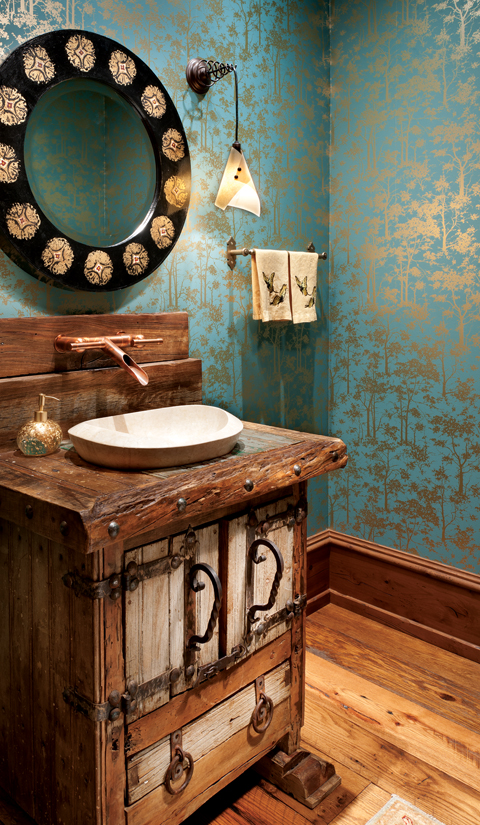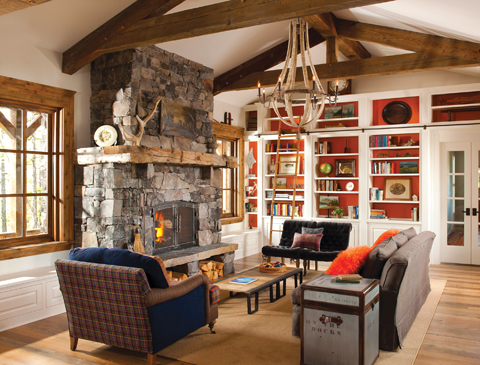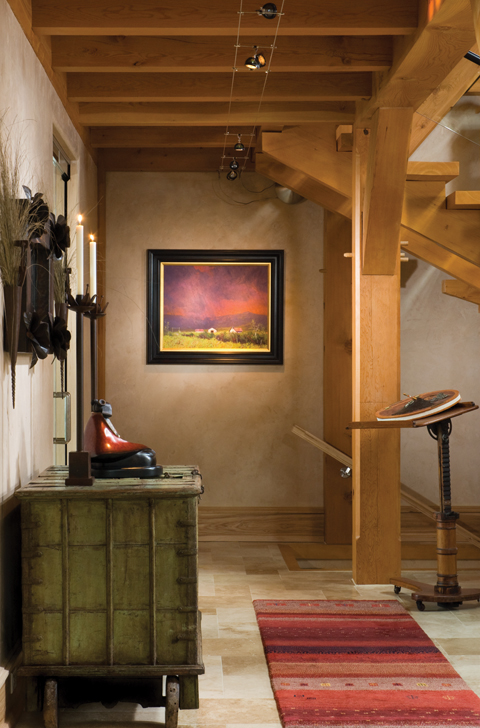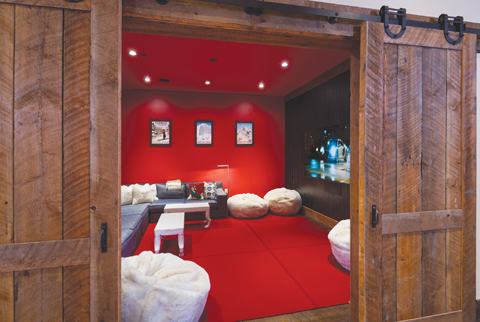If you have chosen to build a log or timber frame home, no doubt it is the beauty of the wood that drew you in. All-log walls are fantastic design elements. By selecting a square or D-log profile, it is easier to hang artwork, display shelves, and cabinetry on the flat interior surface. For a timber frame or post-and-beam home, you can opt for wood walls, but with the use of SIPs (structural insulated panels) between the timbers the sky is the limit for wall treatments. Many homeowners and designers enjoy working with colors and patterns that enhance the wood and add to the home’s decorating style.
If you want to add color and pattern to the walls of your log home you’ll need to make this known during the design process. The architect or designer can designate various walls or rooms for sheetrock that can then be covered in any material from simple paint to intricate tile. You can go bold with a cool, dark color that contrasts beautifully with the warmth of the wood; select a neutral, textured finish that adds to the home’s rustic appeal; or just have fun with a temporary wall finish such as a decal.

Photo by Heidi Long
These days there are literally hundreds of products that can be used to add color and texture to your home. We’ll make a quick survey of some of the options, from tried and true paint to temporary wallpaper to corrugated metal.
Keeping It Simple with Paint
In its basic form, paint is easy to apply, fairly inexpensive, and easy to maintain. It comes in thousands of colors, from neutrals to jewel tones, and can be used with any decorating style. Paint can be used in any area of your home, from an entire room to an accent wall to an accent in a built-in shelf system.
Paint comes in several different “sheens,” each of which impacts how the walls react to light. Flat or matte paint has no sheen and tends to absorb rather than reflect light. It is the most forgiving to apply and may camouflage any wall imperfections. Most flat paint cannot be cleaned, but there are new products on the market that can be scrubbed. Eggshell paint looks a lot like flat paint but has a slight sheen that reflects some light. It can be spot cleaned and is more durable than flat paint. Satin paint has a smooth, shiny surface that reflects light; it is ideally suited to higher traffic areas that require more maintenance. Satin paint is more difficult to apply because it shows brushstrokes and drips. Glossy paint has a high sheen that reflects a lot of light. It is durable and washable, making it perfect for bathrooms and kitchens.
Paint with a Textured Twist
With a few more steps and a little extra work, you can have both color and texture on your walls. Some of the paint techniques have been around for decades while new ones come on the market each year. For example, Ralph Lauren Paint offers a variety of specialty finishes. The Polished Patina finish is achieved by painting the topcoat, which comes in 24 gorgeous colors, over an eggshell base coat. The result is a smooth finish that gives the allusion of texture, lights and darks, and movement. A Suede finish, also from Ralph Lauren, requires a two-step process: simply roll on your chosen Suede color, allow it to dry, then brush on another coat in a crisscross fashion. Your walls will have the look of brushed suede—with more than 40 color choices. Two coats of the company’s River Rock paint will give your walls the weathered look of water-worn stones. If you want your walls to have a lustrous glow, the company offers a Metallic paint in numerous colors that goes up in two simple steps. If you want even more texture, Ralph Lauren offers Indigo Denim, Antiqued Leather, and Bright Canvas paint and techniques.

Dovetail Construction/ Brechbuhler Architects/photo by Karl Neumann
Ralph Lauren is just one of many companies that offer a variety of paints and painting techniques. With a little research and a lot of samples, you’ll find the texture that suits your style.
Eco-Friendly Clay
Few wall treatments are more Earth-friendly than water-based clay plaster. It is 100 percent natural, durable, resists dirt, mold, and fading, absorbs odors, and helps control moisture and humidity. It is also nontoxic and completely free of VOCs (volatile organic compounds).
One manufacturer, American Clay, located in Albuquerque, New Mexico, offers 224 color options plus various original blends to help you achieve the perfect color and texture for your walls. The company sources three-quarters of the clay within 500 miles of its home base, and all of the color additives are made of naturally occurring oxides and minerals from the United States.

Photo by Karl Neumann
You start with natural clay in dry form then mix it with water to apply it; premeasured packets of your selected color are added to the mix and an added binder makes the clay stronger and more workable. American Clay offers four different product lines—Loma, Porcelina, Maritimo, and Enjarre—that will create finishes from smooth to sandy to rustic. Enjarre goes on in a single coat while the other three require a couple of steps. If you want even more texture, the company offers mica and straw additives and various sealers.
If you like to get your hands dirty with DIY, applying clay plaster yourself can be very rewarding. Make sure you do the research and follow the manufacturer’s instructions to a tee and you’ll end up with show-stopping walls.
Wallpaper? … Yes, Wallpaper!
There’s no hint of your grandmother’s cabbage rose wallpaper among today’s offerings. Although it was out of favor for decades, many designers are using wallpaper to great effect these days. Wallpaper designs range from subtle textures to minimal patterns to natural flora and fauna in colors to suit any style. You can go all-natural with a grasscloth or add a bold color or pattern to liven up a space. We’ve seen wallpaper that looks like antique tin panels, cut logs, or a wall of stacked stone. Wallpaper can cover an entire room or, like paint, be applied to an accent wall or to the back of shelving. It can make a room look larger and brighter or give it a cozier, warmer feel. It takes some skill to hang wallpaper properly, and you’ll want to make sure your chosen paper is suitable for its designated space; for example, no all wallpapers can be used in a moist environment such as a bathroom.
One downside of wallpaper is that it’s difficult to remove if you decide you want a new look in your home. Creative companies like Chasing Paper have come up with a solution for those who like to change things up or update their style: temporary wallpaper. While it is ideal for renters and college students, it’s also a fun and practical product for permanent residences. With an enormous variety of colors and patterns, from thin stripes to toile, temporary papers look like the real thing. Most are made of vinyl and are applied like decals. Since the product is forgiving, it’s an easy DIY project for most people.

Photo by Karl Neumann
Found Objects and Recycled Materials
Nothing enhances a rustic home more than materials with a patina gained with age. Reclaimed wood can be used on an accent wall behind a bed, as a fireplace surround, or in a powder room. It blends perfectly with logs and timbers and adds warmth and texture to a room. One example is shiplap, wood that was used to construct walls decades ago, which is now found in reclaimed lumberyards. It makes excellent paneling in its natural state or can be washed or painted to fit your style. Reclaimed corrugated steel and old tin ceiling tiles can also add another texture to your walls, especially if they are left in their natural, found condition. You can really get creative with anything that appeals to you and enhances your home.

